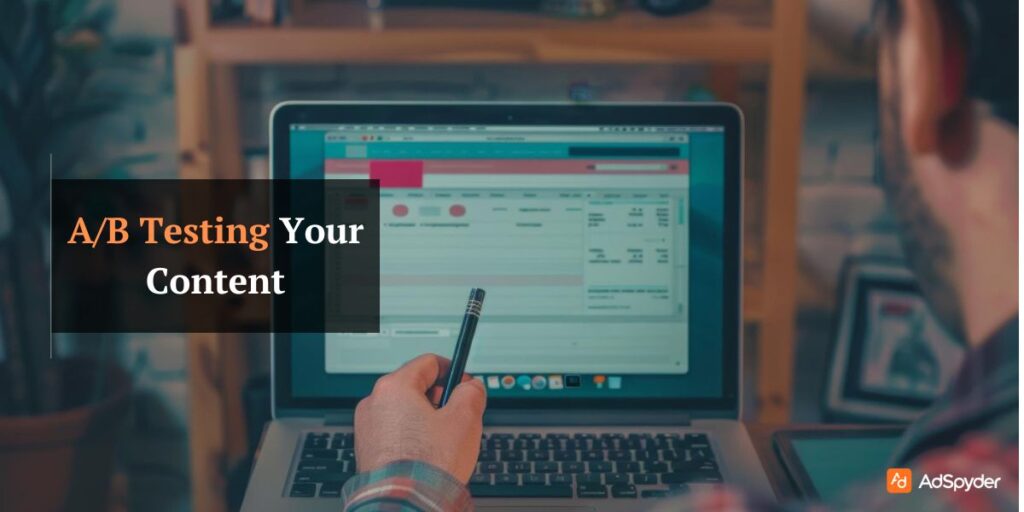The digital world of marketing is changing constantly; hence, high-quality content created alone is not enough for a particular customer to stand out and engage with the target. To ensure your message is deeply resonating and driving the needed actions in the customers, you should have A/B testing, also known as split testing. A/B Testing Your Content is essentially making different versions of the same thing in content, be it the headline, call to action, or an image, and showing it to different audience segments to see which one performs better. Data analysis of the variations can provide you with valuable insights into what users want and how you should tailor your content to maximize its effect.
Ready to Elevate your Marketing Strategy?
This is an in-depth journey into the realm of A/B testing for content marketing. In this post, we’ll look at the advantages of A/B testing, and different elements you can test, walk you through step-by-step and highlight common pitfalls and best practices to ensure your efforts pay off by giving you actionable data to make your content even better.
Summary
This blog post will be your go-to guide on A/B testing for content marketing success. We will delve into the strong reasons to start A/B testing, such as increased engagement, improved conversion rates, and data-driven decision-making. We will also walk you through some of the various content elements that you can test using A/B testing, such as headlines, CTAs, landing page layouts, and video thumbnails. Next, the guide takes you through an A/B test, showing all you need to do to define your hypothesis, develop variations, conduct the test, and analyze your results. This discussion delves into typical problems associated with A/B testing and offers some of the best practices for gathering sound data and perfecting your content for optimal performance.
Why A/B Test Your Content?
A/B testing offers a string of advantages with a content marketing approach. Among its features include:
Data-driven Optimization
This means one cuts down all your speculations playing guess the winner into making correct calls using real data captured by users while perfecting what really will fit you with some parts of its performance as related to an alternate that best has shown some worth coming across when facing any crowd.
Increased Engagement
A/B testing empowers you to identify content elements that capture user attention and encourage interaction. By testing headlines, CTAs, and content formats, you can optimize your content for improved click-through rates, time spent on a page, and overall user engagement.
Increased Conversion Rate
The last end of your content is conversion, whether it’s generating leads, making sales, or signing up. A/B testing will let you know what specific elements of your content result in the highest conversions. Optimizing CTAs, landing page layout, and content offers can make a huge difference in your conversion funnel.
Reduced Bounce Rates
A/B testing will be able to tell you what elements of content drive visitors away. You can create headlines, introductions, and page layouts. These capture the interest of your users from the word go and help reduce bounce rates. It is defined as visitors who view only one page of your website before leaving.
You might find quite a few things that are not as relevant as you thought for performance just through A/B testing. You may even realize that a button colour or a call-to-action wording difference could be one of those critical differences. It can affect if people will engage more or be likely to convert.
With A/B testing, you will understand what your users want and what they prefer. This information will help you create content that will be attractive for your target audience, increase engagement, and, afterwards, conversion and the accomplishment of your marketing goals.
Visit Here – What is Content Marketing and Why is it Important
Elements You Can A/B Test in Your Content
A/B testing isn’t limited to headlines or CTAs. Experiment with different content elements to make the most of your content and get the best of the lot:
- Headlines: Headlines are the first impression your content makes. A/B tests different headline variations to see which ones capture user attention and entice clicks. Test headlines for length, clarity, emotional appeal, and keyword inclusion.
- Content Format: There are several content formats, so understand what people like. Blog posts against infographics, videos against white papers, or ebooks against case studies.
- Visuals: Visuals play a very important role in engaging content. Use A/B testing on different images, videos, or graphics to understand what attracts the eye of the user and complements your content.
- Call-to-Action: This is your call-to-action between content consumption and the desired action. Test different variations of CTA wording, placement, button colour, and the type of call-to-action-download now or learn more to determine which yields the highest click-through rates.
Additional Elements for A/B Test Consideration
- Landing Page Layout: A massive impact on a landing page both on user experience as well as the rate of conversion has the layout. A/B test various layouts from headline placements, CTA placement, and other content-related positions to understand what pushes visitors toward better conversion.
- Content-Length: Although long content builds credibility, it might be too much for your user to read. Test different content lengths to figure out which will work the best for your audience and type of content.
- Content Structure: Test several structures for your content. Test the following variations: bullet points vs paragraphs numbered lists vs sidebars short introductions vs in-depth introductions to determine which structures are more readable and user engagement-boosting.
- Mobile Responsiveness: When people surf more and more on mobile devices, your content must be responsive to all devices. Use A/B testing to test different variations of mobile layout and functionality to optimize for smartphones and tablets.
- Personalization: Personalization is probably the most important feature that can uplift engagement. Run an A/B test on elements like a headline or CTAs based on demographic, browsing, or interaction data to figure out if it even enhances user experience and makes for better conversions.
Related – How Small Businesses Used Content Marketing to Grow
The A/B Testing Process: Step by Step
Well, now that you know all these benefits of A/B testing and what you can test, let’s get into the A/B testing process:
Define your goals and hypothesis
What is it that you’re trying to achieve from doing the A/B test? Do you want more clicks on the call-to-action, fewer bounces, or more conversions? Make yourself explicit about why you’re doing the A/B test. Having been pushed to commit your goals to writing as some kind of map, you can now go and hypothesize. For example: “We hypothesize that replacing headline X with headline Y would drive a 20 per cent lift in clickthrough rate on our CTA.”
Choose the Content Element to Test and Create Variations
Select an element of content on which you would hypothesize where you want to make optimizations. Make sure that you select one at a time so that you easily know what has an impact effect from among all your changes. Prepare variants on the element of content to test. For example, in headline testing, make sure that there are two headlines with at least three words using difference and contrast value propositions both in the differences and also different lengths.
Select A/B Testing Tool
There are numerous A/B testing tools, free and paid. Some of the most prominent ones include Google Optimize, Optimizely, VWO, and Crazy Egg. All these allow for an easy setup of variations and the splitting of traffic, easily trackable.
Set up and Run Your Test
Implement the test through your chosen A/B testing tool. You should define sections of audiences to receive other versions, test duration length, and success metrics to follow during your test. You are running the A/B test, then it’s verified that the test functions correctly. Monitor the key metrics by utilizing the A/B testing tool while running.
Conclusion of Results Analysis
Run the test for a statistically significant amount of time, long enough to gather reliable conclusions. Then, analyze the results and see which variation did better according to your success metrics.
Implement the Winning Variation
Use the winning variation identified from analyzing the best outcome based on your goals and employ it in your content for optimized performance.
Refine and Iterate
AB testing is a continuous process. Find the new elements and continue to refine your content with data-driven insights. Iteration and optimization of content make sure that your content is always relevant and high-performing. AB testing is a scientific process. Analyze the results objectively. Avoid confirmation bias, but let the data determine the real winner.
Check Out – Content Marketing Strategies for Nonprofits
Common Obstacles to A/B Testing and How to Conquer Them
A/B testing is a strong weapon but not without challenges. Here are common problems and how to overcome them:
Statistical Significance
Run your A/B test long enough and collect enough data such that comparisons between the control and treatment groups will yield statistically significant results. Use sample size calculators online to calculate the required test duration for your desired target audience size and desired level of statistical significance.
Traffic Volume
The smaller the amount of website traffic, the more time it would take to accrue enough statistically valid data to be able to use in an A/B test. Strategically segment your audience or find other websites that could potentially increase your sample size on a test.
Testing Too Many Elements at Once
Avoid the temptation to test too many elements at once. Test one element at a time to isolate the impact of the change and identify the true cause of performance improvements (or declines).
Clear Hypothesis Definition
A good hypothesis is very important for successful A/B testing. Make sure your hypothesis is SMART-specific, measurable, achievable, relevant, and time-bound to guide your test design and analysis.
Testing for Long Periods
However, make sure you have enough data; do not run A/B tests for too long. Once you have a clear winner, apply the winning variation and move on to test a new element. Running a test for too long will make you lose precious time for optimization and hinder the ability to iterate over your content.
Negative A/B testing results do not impress one
Even results that do not favour a clear winner are not futile. Analyze data about why a variation was ineffective, deriving insights that can then be used to fine-tune your content strategy in future tests.
Process Documentation
Track every detail of the A/B testing process. Record your hypothesis, variations tested, test duration, and key findings. This will be extremely helpful for later reference and analysis to track progress over time and find patterns.
Not Acting on the Outcomes of Testing
The final goal of doing A/B testing is to translate data into actual decisions. One should not find themselves collecting plenty of data without any apparent reason. Perform the version that performed better from your findings while iterating the best version for maximum improvement in the content.
By recognizing these challenges and implementing some of the proposed solutions, your A/B testing efforts will always yield valuable data and contribute toward a data-driven content marketing strategy.
Recommended For You – The Benefits of Using a Content Management System (CMS)
FAQs
What are some free or low-cost A/B testing tools?
Here are a few of the most popular ones:
- Google Optimize
- Optimizely Freeplan
- VWO Engage
- Hotjar Heatmaps
How long should I run my content’s A/B test?
Some online sample-size calculators will make you decide on the appropriate length to test that fits your requirements. More often than not, collect enough data so that your results will yield a confidence level of 95%.
What metrics should I measure during an A/B content test?
Most of the A/B testing revolves around the following metrics:
- Click-through rates (CTRs)
- Conversion rates
- Bounce rates
- Time on page
- Social shares
Would it be possible to compare the differences between the two types of content? For example, a blog compared to an infographic?
Absolutely! A/B testing does not apply only to the text-based content elements. Test other formats of content that might best appeal to your target audience.
How will I know that my A/B test results are valid and reliable?
Ans:- Some best practices that can be employed to ensure the reliability and accuracy of your A/B test results are as follows.
- Proper setup of the A/B testing tool
- Statistical significance
- Clear hypothesis and goals
- Control external influences
Is A/B testing good for B2B content marketing?
A/B testing is also very precious for B2B content marketing. You could A/B test headlines, CTAs, the layout of the landing page or even the actual content offer depending on your particular B2B audience.
How do I implement A/B testing data in my content strategy?
A/B testing data is a treasure trove for the development of your content strategy. Use the results to analyze what works with your audience and what does not work. Take these findings and craft content.
Conclusion for A/B Testing Your Content
Recap
This comprehensive guide has given you the knowledge and tools to help you make the most out of A/B testing when it comes to content marketing success. We discussed why A/B testing is a fascinating activity, among which but not limited to: data-driven optimization, increased engagement, improvement in conversion rate, and a drop in the bounce rates. We entered several pieces of content that could be A/B tested, ranging from headlines and CTAs to landing page layouts and video thumbnails.
It walked you step-by-step through the A/B testing process and defined some key stages: a hypothesis, variation creation, test running, and results analysis. We have covered the most common problems that arise with A/B testing and provided best practices to ensure you are gathering reliable data and optimizing your content for peak performance. We also explored A/B testing in B2B content marketing and gave insights into how to apply the results of A/B testing to inform your overall content strategy.
Final Thoughts
A/B testing enables you to shift the game of content creation from guessing to science. It is embracing A/B testing as a continuous measurement process, analysis, and fine-tuning your content so that it hits the chord you’re trying to reach and serves the results you’re after. Remember, A/B testing is an ongoing process. Do not be afraid to try things, learn from the outcome, and improve your content strategy step by step.
Call to Action
Ready to tap into the power of A/B testing to take your content marketing to the next level? Here are some actionable steps to get you started:
- Identify Your Content Marketing Goals: Set clear goals on what you aim to achieve from content marketing. Is it for increased website traffic, lead generation, brand awareness, or revenue generation?
- Prioritize Content Elements to Test: Based on your objectives and your instincts, you are going to want to select some content elements you feel may make an impact on a user’s behaviour.
- Select your A/B Testing Tool: There are many free as well as paid A/B testing tools. Have a look at the options that are listed above (Google Optimize, Optimizely, VWO, Hotjar).
- Develop Compelling Variations: Develop variations of the selected content element that differ strategically but work for your target audience.
- Set Up and Run Your Test: Set audience segments, the length of time for testing and the most key metrics that would be used for testing.
- Analyze Results and Act: Once the test is completed with enough data collection, analyze which variation is performing better and act on the information to use throughout your content.
- Accept Continuous A/B Testing: A/B testing is a journey and not a destination. Continuously identify new things to test. Experiment with different content formats and approaches
By doing so and following this up with data-driven content marketing, you shall be able to differentiate your good content, unveil its full potential and hence long-term success. Sincerely, the voice of the people is the ultimate arbiter that determines your content as A/B testing empowers one to listen and understand their voices through data which enables optimization on their preference and in the end will craft content to resonate, to engage, and to convert.




